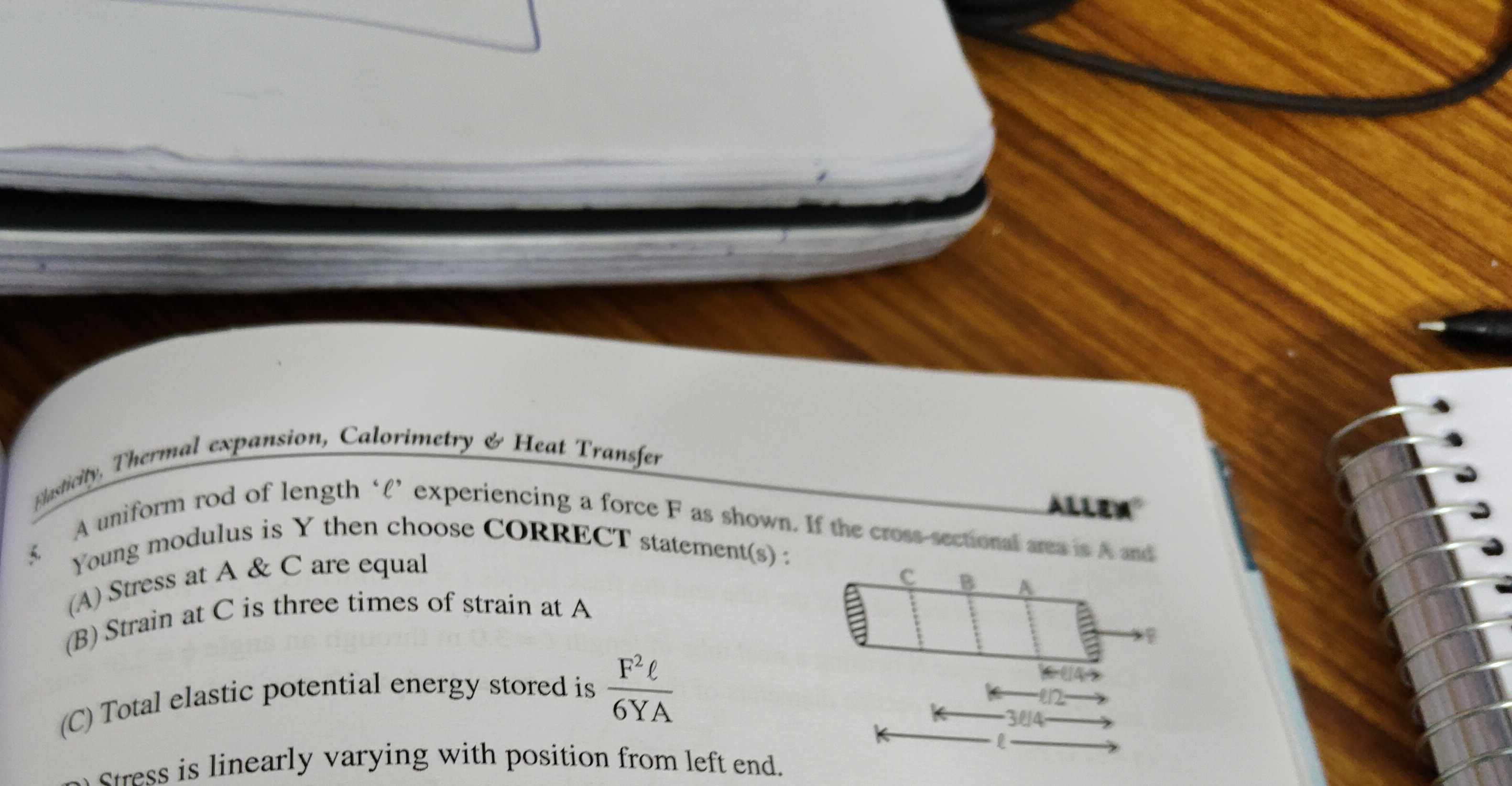Question
Question: A uniform rod of length 'l' experiencing a force F as shown. If the cross-sectional area is A and Yo...
A uniform rod of length 'l' experiencing a force F as shown. If the cross-sectional area is A and Young modulus is Y then choose CORRECT statement(s): Stress is linearly varying with position from left end.

Stress at A & C are equal
Strain at C is three times of strain at A
Total elastic potential energy stored is 6YAF2l
Total elastic potential energy stored is 6YAF2l
Solution
Let 'y' be the distance from the left end of the rod. The problem states that the stress is linearly varying with position from the left end. We can write the stress σ(y) as a linear function of 'y': σ(y)=σL+ky where σL is the stress at the left end (y=0) and 'k' is a constant.
The force F is applied at the right end (y=l). So, the stress at the right end is σ(l)=F/A. σL+kl=F/A.
Assuming the rod is fixed at the left end, the reaction force at the left end is Freaction=AσL. For equilibrium, the applied force F at the right end and the reaction force at the left end must balance if they act in opposite directions. Thus, Freaction=−F. This implies AσL=−F, so σL=−F/A.
Substituting σL into the equation for the right end: −F/A+kl=F/A kl=2F/A k=Al2F
So, the stress distribution is σ(y)=−F/A+Al2Fy.
Let's evaluate the statements: Points A and C are located at distances l/4 and 3l/4 from the right end, respectively. This means their distances from the left end are: yA=l−l/4=3l/4 yC=l−3l/4=l/4
Statement (A): Stress at A & C are equal Stress at A: σA=σ(yA)=−F/A+Al2F⋅43l=−F/A+2A3F=2AF. Stress at C: σC=σ(yC)=−F/A+Al2F⋅4l=−F/A+2AF=−2AF. Since σA=σC, statement (A) is incorrect.
Statement (B): Strain at C is three times of strain at A Strain at A: ϵA=σA/Y=(F/2A)/Y=2AYF. Strain at C: ϵC=σC/Y=(−F/2A)/Y=−2AYF. For ϵC=3ϵA: −2AYF=3⋅2AYF⟹−1=3, which is false. Statement (B) is incorrect.
Statement (C): Total elastic potential energy stored is 6YAF2l The elastic potential energy stored in a small element of length dy at position 'y' from the left end is dU=21σ(y)ϵ(y)Ady=21Yσ(y)2Ady. The total potential energy U is the integral from y=0 to y=l: U=∫0l2YAσ(y)2dy=∫0l2YA(−AF+Al2Fy)2dy U=2YA(AF)2∫0l(−1+l2y)2dy=2YAF2∫0l(l2y−1)2dy Let u=l2y−1. Then du=l2dy, so dy=2ldu. When y=0, u=−1. When y=l, u=1. U=2YAF2∫−11u2(2ldu)=4YAF2l∫−11u2du U=4YAF2l[3u3]−11=4YAF2l(313−3(−1)3)=4YAF2l(31+31) U=4YAF2l(32)=6YAF2l. Statement (C) is correct.
